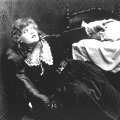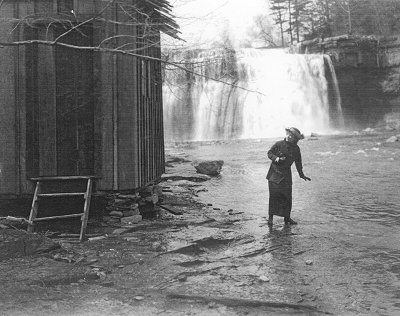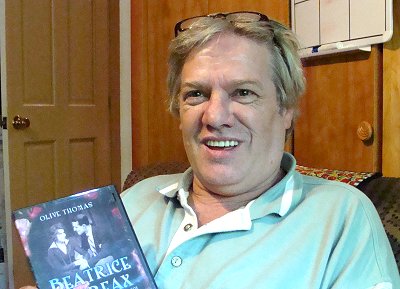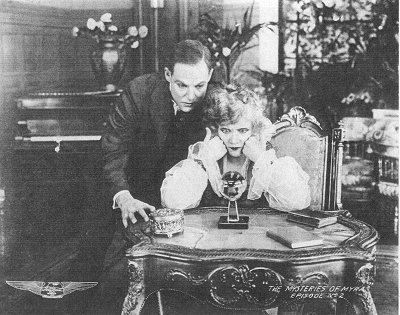- By Dan Veaner
- News
 Print
Print  In 1916 Ithaca's Wharton Studios filmed 'The Mysteries of Myra ,' a 15 part serial with an occult theme. It was based on a story by Hereward Carrington, and Harry Houdini served as a technical consultant to the film's directors Theodore and Leo Wharton. Few of the Whartons' films still exist, but that will change this summer when Episode 1, 'The Secret Chamber' is recreated. While the new production company is based in Pennsylvania, some of the filming will take place at the original locations in Ludlowville. Local film historian Terry Harbin plans to show the locations to director Eric Stedman as well as some of the cast tomorrow.
In 1916 Ithaca's Wharton Studios filmed 'The Mysteries of Myra ,' a 15 part serial with an occult theme. It was based on a story by Hereward Carrington, and Harry Houdini served as a technical consultant to the film's directors Theodore and Leo Wharton. Few of the Whartons' films still exist, but that will change this summer when Episode 1, 'The Secret Chamber' is recreated. While the new production company is based in Pennsylvania, some of the filming will take place at the original locations in Ludlowville. Local film historian Terry Harbin plans to show the locations to director Eric Stedman as well as some of the cast tomorrow."We plan on filming some of the episodes from this series that is lost," Harbin says. "None of the original footage exists, except for some parts that are in museums in England. We're attempting to get some actual footage from them, but other than that it's lost."

Ludlowville Falls from a 1916 episode of 'Mysteries of Myra'
What does exist is the scripts and a series of still pictures the studio made to document the filming. Harbin says there are few stills from before the 1916 period. That makes the 'Mysteries of Myra' project make sense, because many pictures show sets and locations, props and costumes, placement of actors, and even give a sense of the acting style of the period.
As part of his research Harbin has done detective work, finding original Ithaca film locations by matching old buildings to pictures from Wharton films. While a photograph may show only a small piece of a house, Harbin pays close attention to architectural details to identify the actual locations. A number of pictures from the Myra series were taken at Ludlowville Falls, and Harbin says the new films will use the same locations there. Harbin recently moved to Ludlowville.
"This was an area where I knew the Whartons had filmed," he says. "Ted Wharton had come to Ludlowville to visit relatives in 1912. His first impression of this area began in Ludlowville. I'm here now, within walking distance of the locations. That's how Ted Wharton discovered it."
Harbin says that while the stories say Wharton went to Ithaca first, he thinks Wharton actually got his first impressions from Ludlowville. Then he went to Ithaca, which sealed his love affair with the area. Harbin notes that people Wharton knew have Lansing roads named after them, including Sarah Buck, and Wharton's attorney Howard Cobb. He says that Ludlowville was the first place he shot his films, and Ludlowville offered perfect settings for the 'Myra' series. The existing pavilion in Ithaca's Stewart Park is part of the original Wharton Studio building. A plaque on the wall there commemorates the studio.
The plot is typical of the serials of the period, the most famous of which is 'The Perils of Pauline,' replete with melodrama and cliffhangers. On her 18th birthday Myra discovers that she has been marked for death by 'The Black Order,' a cult her father once belonged to. That begins a series of perils that Myra must escape from with the help of Dr. Payson Allen, a specialist on cults. The series lasted for 15 episodes, andHarbin says that the quality was sketchy.
"Around episode six it loses it a bit," he says. "It wasn't a blockbuster, but the last episode was good."
The original cast featured Jean Southern as Myra, and Howard Estabrook as Dr. Payson Allen. The new cast includes Charles Leeder, Jeff Moffitt, Brynne Gallagher and Krista Bryant. The new film will start with a modern-day Myra who inherits her family's home. She learns her great grandmother's sister Myra lived in the house she just inherited, and that leads her into the past and into the original adventure.

Terry Harbin
Originally from Cleveland, Harbin moved to Ithaca when he was 18. He became interested in local film making when he discovered his then wife's grandfather had been an extra in local films, including a scene filmed in Stewart Park. He works at Tompkins County Public Library, and became involved with a series of public access television productions the library created for the Centennial.
"I started researching the movies, and I just never stopped," Harbin says. "I was interested in moving images and what they were doing then, and comparing it to what I was doing now. I was interested in how it all began."
After over 20 years of research Harbin says he could write a book, but feels he still has much to learn. It has been a passion of his to find ways to share accurate information about the Ithaca film industry, and he has been working on a Web site called IthacaMadeMovies on which he documents much local film history.
"The most satisfying part is seeing other Internet entries that I know came from what I wrote, trying to get the facts correct," he says. "When you repeat things over and over and it's in print, then that becomes history. Some of the stuff that was wrong in the past -- I felt it was good to get people to talk about the real movies that were made here instead of the ones that weren't."
Today he is planning to update the site to make it more attractive and accessible. In addition he has released two DVDs of 'Beatrice Fairfax' episodes. He found a copy of the footage that was being prepared for tinting, but the scenes were not in order. Harbin researched the scripts and re-edited the adventures, resulting in the DVDs. He says helping in the remaking the lost episodes of 'The Mysteries of Myra' is another way he can insure that Ithaca's film history is not lost forever.

A crystal ball prop was purchased this week to recreate
this 'Mysteries of Myra' scene
In 2005 Harbin met Stedman, who helped distribute DVDs, and who hosts the Serial Squadron Web site. It made sense that the two would collaborate on 'Myra' with Harbin living in the midst of the original locations. The result will be an engaging look at a lost art, and especially at a local lost work. Harbin says that it is important to preserve Ithaca's film tradition.
"My favorite part is that someone is finally doing something about it," he says. "When I made the shows for public access I realized it would all be lost, the same way the Wharton films were. So I made a documentary and made all the things I did into one program so it can't be forgotten. I felt I need to do the same thing for the Whartons."
Original 'Mysteries of Myra' photos from the collection of Terry Harbin, used with permission
----
v6i20



